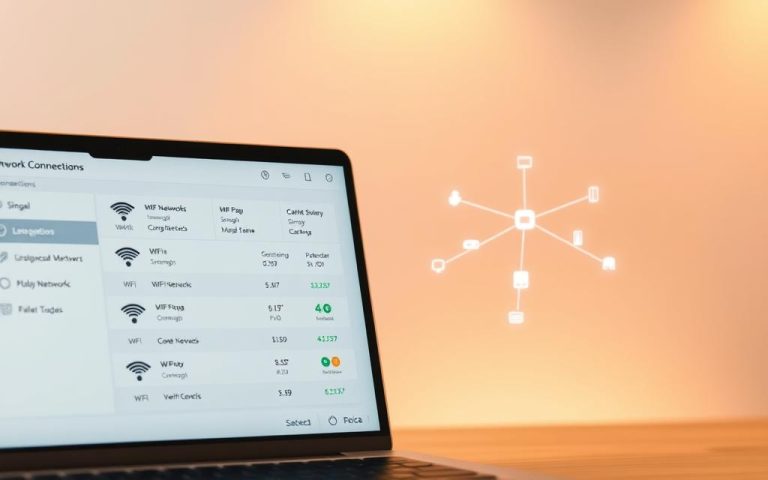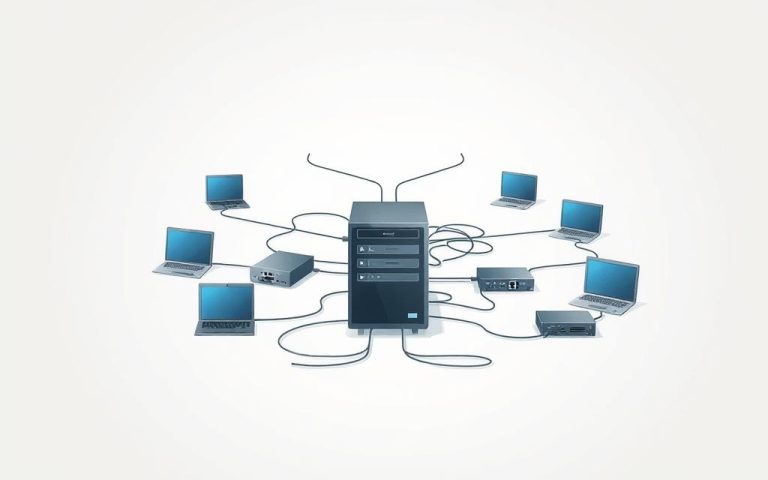What Is Networking in Computer Networks? Definition & Uses
Computer networking is a complex system of linked devices. It allows smooth data sharing across digital platforms. This process helps organisations and people share resources and communicate effectively.
Modern networking tech enables swift information exchange worldwide. It forms the digital backbone of today’s communication systems. From small offices to large enterprises, networking is essential.
Networking began with ARPANET in the late 1960s. Now, networks range from simple two-laptop setups to global internet systems. These use advanced protocols for reliable data transmission.
Key networking components include wired and wireless connections. Wired networking often offers better speed and security. The infrastructure supports various network designs for flexible communication.
New tech is changing networking capabilities. AI and machine learning are set to improve network performance. They’ll particularly enhance security measures1.
Understanding Computer Network Fundamentals
Computer networks connect devices and enable data exchange. They form the backbone of modern digital communication. These systems rely on crucial components that work together efficiently2.
Key elements ensure smooth communication between devices. The fundamental network components include:
- IP addresses for device identification
- Nodes as connection points
- Routers for directing data traffic
- Switches for managing network connections
Essential Network Infrastructure
An IP address uniquely identifies each device on a network3. The IPv4 standard uses 32-bit addresses, allowing over 4 billion unique identifications.
The newer IPv6 provides an expanded 128-bit address space3. Nodes act as critical connection points in network architecture.
Routers direct data between different network segments. Switches enhance network performance by managing local device connections2.
Network Communication Protocols
Networks use sophisticated protocols for communication. The TCP/IP model forms the foundation of most internet structures2.
Devices use various ports to establish specific connections. There are 65,536 potential port numbers available for different services3.
Networks have evolved from military origins in the 1950s to become the global communication infrastructure we rely on today2.
These core network components connect billions of devices worldwide. They provide insight into how modern digital communication operates4.
What is Networking in Computer Network
Networking in computer networks is a vital technological framework. It allows seamless communication and resource sharing across digital platforms. This concept has evolved greatly since the 1960s, changing how we exchange information.

Network communication involves several key processes for data exchange. These include connecting devices, sharing resources, and supporting collaborative environments. Secure and efficient information transmission is also crucial.
- Establishing connectivity between multiple devices
- Enabling resource sharing across different platforms
- Supporting collaborative digital environments
- Transmitting information securely and efficiently
Modern networking technologies have grown impressively. Networking speeds now exceed 100 Gbps in current routers and switches. The rise of IoT devices has sped up the growth of interconnected digital ecosystems5.
| Network Type | Coverage | Primary Function |
|---|---|---|
| Local Area Network (LAN) | Up to 10 kilometres | Internal organisational communication |
| Metropolitan Area Network (MAN) | City-wide | Regional data transmission |
| Wide Area Network (WAN) | Global | International data exchange |
Professional networking skills require a diverse approach. They combine technical expertise with strategic thinking. Experts need strong maths and programming skills to design complex network infrastructures5.
Networking is not just about connecting devices; it’s about creating intelligent, responsive digital ecosystems that transform how we communicate and collaborate.
Types of Network Architecture
Network architecture shapes how computer networks are structured. It determines how devices communicate and share resources across different network configurations. This knowledge helps organisations choose the best network design for their needs6.
Networks mainly use two basic architectures: client-server and peer-to-peer. Each approach offers unique benefits for different computing environments7.
Client-Server Networks
Client-server networks centralise processing and storage through dedicated servers. These servers provide resources to connected client devices7. This model supports key functions like file sharing and database management.
It also handles email services and web hosting. The architecture ensures a strong network topology with better security and resource management6.
However, setting up client-server networks can be costly. This is due to the need for sophisticated hardware7.
- Efficient file sharing
- Database management
- Email services
- Web hosting
Peer-to-Peer Networks
Peer-to-peer (P2P) networks allow devices to share resources directly. They don’t need a central server8. These networks work well for small-scale file sharing and messaging platforms.
P2P networks also suit gaming environments. They can be structured or unstructured, offering flexibility for various needs6.
P2P systems are typically cheaper and easier to set up than client-server networks7.
- Small-scale file sharing
- Messaging platforms
- Gaming environments
| Network Architecture | Key Characteristics | Best Use Cases |
|---|---|---|
| Client-Server | Centralised resources, high security | Large enterprises, critical services |
| Peer-to-Peer | Distributed resources, low cost | Small networks, collaborative environments |
Enterprise Network Solutions
Enterprise networks are complex digital systems that support modern business operations. They allow organisations to communicate and share resources across multiple locations. These networks can adjust their capacity based on demand, using automation and smart monitoring.
Local Area Networks (LANs) connect devices within a single office or building. They are vital for small companies, helping them communicate and share resources efficiently. Many networking solutions now include built-in security features to protect sensitive business data9.
Wide Area Networks (WANs) extend enterprise connectivity beyond local boundaries. They span buildings, cities, and even countries, ensuring secure and reliable long-distance communication. Software-Defined WAN (SD-WAN) offers flexible connectivity services controllable at the application level9.
Cloud-based network solutions are changing enterprise networking. They host network capabilities and resources in cloud environments. This approach provides on-demand access to virtual routers, firewalls, and bandwidth. It helps organisations create more flexible network infrastructures that support their changing needs.
FAQ
What is computer networking?
How do IP addresses work in networking?
What are the primary types of network architectures?
What is the difference between LAN and WAN?
Why are network protocols important?
What role do routers and switches play in networking?
How has networking transformed business operations?
What are some emerging trends in enterprise networking?
How do network topologies impact performance?
What is the importance of network security?
Source Links
- https://www.techtarget.com/searchnetworking/definition/networking
- https://www.spiceworks.com/tech/networking/articles/what-is-a-computer-network/
- https://www.geeksforgeeks.org/basics-computer-networking/
- https://www.theknowledgeacademy.com/blog/what-is-a-computer-network/
- https://www.unr.edu/cse/undergraduates/prospective-students/what-is-networking
- https://www.splunk.com/en_us/blog/learn/network-architecture.html
- https://www.geeksforgeeks.org/classification-of-computer-network-on-basis-of-architecture/
- https://www.kentik.com/kentipedia/network-architecture/
- https://aws.amazon.com/what-is/computer-networking/













